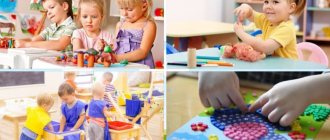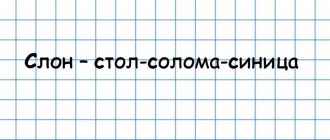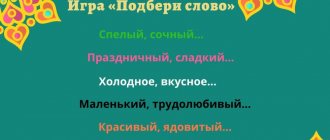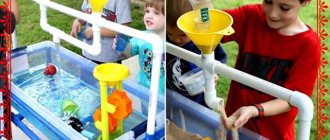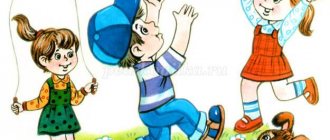What is associative thinking and why is it important to develop it in children?
Association is a mental, tactile or visual connection when, upon contact with one object, other images, phenomena, situations are remembered. Consequently, associative thinking is the ability to think figuratively and find analogies. This helps to understand and remember information and generate ideas. For example, if the password for a bank card is 1812, then the Napoleonic wars immediately come to mind. By remembering them every time you make transactions at an ATM, a person will enter the correct code.
In order for a child to grow intellectually developed, his associative thinking must be regularly stimulated. The goal of the game “Associations” is to teach a preschooler to use his imagination every time when memorizing new information, to sort out in his memory what the information received can be associated with.
There are 4 types of associations:
- by similarity - external, functional, structural, semantic (fire-bonfire);
- in contrast (hot-cold);
- by spatial-temporal connection (meat-cutlet);
- by cause-and-effect relationship (dampness-cold).
MAGAZINE Preschooler.RF
Didactic games on Velcro - as a means of cognitive development of preschool childrenRelevance of Velcro games:
- The full development of a child’s personality is possible with the formation of the child’s cognitive activity and creative abilities in preschool childhood, in the process of various types of children’s activities.
- To build a variety of activities for a preschooler, various forms, methods, methods and means of work are used, which support children's activity and initiative.
- Didactic games can be considered a means of developing cognitive activity. Didactic games occupy one of the main places in the development of a child’s cognitive sphere. Touching on all educational areas, didactic games develop preschoolers' horizons, expand their knowledge and understanding of the world around them.
- One of the varieties of didactic games is “Velcro Games”
The purpose of such games:
- Velcro games, thanks to non-standard and bright albums, help to cultivate interest in the world around us, the ability to explore and creatively search, the desire and ability to learn.
Objectives of Velcro games:
- They form a holistic picture of the world, broaden their horizons, enrich their vocabulary and develop coherent speech, and contribute to the formation of elementary mathematical concepts.
- They develop visual, auditory, tactile perception, imagination, spatial thinking, hand-eye coordination, fine motor skills.
- Enrich children's gaming experience.
Advantages of Velcro games:
- Bright, colorful, realistic, visual albums - they are really fun to play with.
- Wide variety of game options. Everything depends only on the imagination of the teacher.
- They affect all areas of a child’s development - the development of speech, phonetics and sound culture of speech, elementary mathematical concepts, familiarization with the outside world, plot and theatrical games.
- Develop imagination, attention, memory, thinking and emotional intelligence.
- Develop fine motor skills, tactile sensations, and perseverance.
- (not unimportant) Moisture-resistant, durable, thanks to Velcro, parts do not get lost.
- Quite mobile.
Today, many useful aids and toys are sold to help both parents and specialists. But we all know that a game made by hand is of particular value. The soul and love for what they do is put into such games, so they turn out so colorful and friendly, which is very important for preschoolers.
I would like to present to your attention which Velcro games I have personally made and used in working with preschoolers, and how these games can be used in different educational areas.
Games for cognitive development (FEMP): games for classification by color, size, shape, counting games, finding half/whole/part
Games for speech development: games with words and games based on plot pictures, for the development of monologue and dialogic speech
Games for forming ideas about objects in the surrounding world: for example, the game “Farmer” (getting to know pets)
Artistic, aesthetic and speech development: games for
telling fairy tales, composing fairy tales with already familiar characters
etc..
The children enjoy learning while playing.
Conclusion:
Velcro games help cultivate interest in the world around us, the ability to explore and create creatively, and the desire and ability to learn.
| Next > |
Rules of the game "Associations"
The didactic game “Associations” exists in many variations. It arouses interest among children of all age groups and is played in pairs and in large groups. The general principle is simple: one player names a word, picture, object, or depicts what is intended with facial expressions. The rest, having understood the information received, come up with associations.
The level of difficulty varies depending on the age category of the children and their general intellectual development. For pupils of the younger age group, you should choose simple words and images and build short associative chains from them. Senior preschoolers and schoolchildren find it interesting to play complex games where they need to form long chains.
Association games are:
- verbal – chains are formed by words;
- figurative – images, facial expressions, body movements are used;
- subject - objects are demonstrated.
Games for imaginative and associative thinking
"Association"
Purpose: a game for imaginative and associative thinking, designed for high school age, develops logical thinking. Type of activity: mental. Number of participants: 10-15 participants. Required Equipment: Does not require the use of equipment.
Description of the game: the leader leaves the room (moves away from the group of players) so that the players can make a wish for one participant from the circle of participants. When the leader returns, he asks the circle questions (you can ask one question to the whole circle, you can ask each player a question), for example: “What kitchen furniture do you associate it with?”, “Which flower?”, “Which animal?” etc. Having received a sufficient number of answers, the presenter makes his choice. If the choice is correct, then the guessed player takes the place of the leader, but if the leader does not guess correctly the first time, then he is given two more attempts. If he doesn’t guess even then, then he fulfills one wish of the game participants (crow under the table, make a victory lap around something, etc.)
"Association" (variant)
Purpose: a game for imaginative and associative thinking, designed for high school age, develops logical thinking. Type of activity: mental. Number of participants: 4 participants. Time: unlimited. Required Equipment: Does not require the use of equipment.
Description of the game: the participants of the game sit opposite each other (crosswise) to form two teams of two participants. Members of each team sit opposite each other. One of the players thinks of a word that he whispers into the ear of his neighbor, that is, a member of the opposing team. Now one member of each team knows this word. The team member who has been given the floor starts the game. He must say a word (not just a single-root word in the nominative case without a preposition) with which, in his opinion, his partner should associate the intended word. If the partner does not guess the intended word, then the turn goes to the player who guessed the word. In addition to one of his new words, he can use words already spoken (again, not words with the same root in the nominative case, without prepositions), thereby building a logical chain. The game continues until the intended word is named. The next player to guess a new word is the one who was guessed for the previous time.
"How are you doing?"
Goal: remember the rules of etiquette, develop dexterity and dexterity. Type of activity: physical. Number of participants: unlimited. Time: unlimited. Required Equipment: Does not require the use of equipment.
Game description: players stand in a circle facing the center. One of the players, the host, walks along the outside of the circle, behind their backs, and selects another player (guest), tapping him on the shoulder. The owner shakes the guest’s hand, identifies himself and very carefully asks: “How are you doing?” The guest says his name and very politely answers his question: “Wonderful, thank you,” but the host, obviously, is very hard of hearing, so he asks again: “How are you?” To which the guest again repeats his answer. But the owner does not calm down and asks again. The guest, with difficulty restraining his irritation and abandoning all decency, repeats his answer loudly. This is where the action begins. The host runs in a circle in the same direction as at the beginning, and the guest runs in the opposite direction. Each of them needs to come to the guest's place first. When their paths cross, they must stop, shake hands and repeat their dialogue three times from beginning to end. Whoever loses the race will be the host in the next round.
"Karaoke in Russian"
Goal: develops artistic abilities, helps each participant in the game to relax. Type of activity: physical, mental. Number of participants: unlimited. Time: at the discretion of the presenter. Necessary equipment: player, headphones.
Description of the game: one is selected from a group of participants (optional). He will be a pop star and will perform a song. They turn on the player to the highest volume so that he cannot hear his own voice. The performers will inevitably scream and howl like crazy, and the audience will need time to stop laughing between the "singers" performances. After the concert, small prizes can be distributed to everyone, and the main prize will be awarded to the best according to the jury.
"Contact"
Goal: develops vocabulary, ability to ask questions correctly, identification of an intellectual leader. Type of activity: mental. Number of participants: unlimited. Time: at the discretion of the presenter. Required Equipment: No special equipment required.
Description of the game: the presenter thinks of a word (noun) and names the first letter to the player. Their task is to guess this word by asking questions to the presenter, indirectly asking about the meaning of the intended word. If the leader does not know what word he is being asked about, and there is another player who knows this word and can name it at the same time as the questioner (in this case, he says “contact”), then the leader says the second letter of his word. Do this until the word is guessed. For example: a word starting with the letter “D” is guessed. The presenter is asked: “Isn’t this something that’s German and flies?” Presenter: “This is not an airship.” “Isn’t this what goes into making doors?” "This is not a tree." “Isn’t this the choir director?” Host: “I don’t know such a word.” Two players playing: “Conductor.” Presenter: “The second letter E.” And so on.
"Eco-web"
Purpose: a tight game that gives the opportunity to show participants the dependence of various biological structures on each other and their influence on each other. Type of activity: mental. Required equipment: a ball of thread. Number of participants: 10-12 participants. Time: 15-20 minutes.
Description of the game: all participants in the game stand in a circle. The leader has a ball of thread in his hands. He starts the game and says the first word, for example: “Earth.” Keeping the tip of the thread in his hands, he throws the ball itself to any player, who in response says: “Tree” (since it grows on the ground) and throws the ball to the next player, not forgetting to leave the thread in his hand. All the following participants pass the ball to each other, naming the following derivatives of the earth: tree, grass, (on the tree) squirrel, nuts (from the squirrel), seeds (from nuts), etc. After the last player has spoken, the presenter draws the participants’ attention to the cobweb that has formed in the center of the circle and asks them to think about what will happen to the story we have invented if some connection is broken.
"Table Racing"
Goal: develops imagination, allows players to feel like real drivers of sports cars. Type of activity: physical and mental. Necessary equipment: A-4 paper, felt-tip pens, tables. Number of participants: unlimited. Time: 40-50 minutes.
Game description: players receive paper and markers. They are asked to use their imagination and draw the racing car of their dreams. The car should be almost flat, like a bird's eye view. The car is given a number and a name. It is very important that the front and rear of the car are different. After this, the competition begins. One representative from each team competes at the same time. The start and finish are marked on the table. The owners of the “machines” blow lightly on the back of the machine so that it moves smoothly along the table. Those cars that fall off the table or start spinning in one place are disqualified. You can have races against time or among each other.
"Pull"
Purpose: allows you, by demonstrating your physical capabilities, to unite the team or to defuse the situation and relax. Type of activity: physical. Required Equipment: No special equipment required. Number of participants: unlimited. Time: 10-15 minutes.
Description of the game: all male participants stand in a circle as closely as possible and clasp their arms around each other. The participants try in every possible way to pull the participants out of the circle, while the latter try to resist. The last participant standing in the circle wins. Participants should not push participants away - just hold on to each other and try to stand
"Rain"
Purpose: tight game - imitation of the sound of rain, develops imagination, attention, and speed of reaction. Type of activity: mental, physical. Required Equipment: No special equipment required. Number of participants: 7-15 participants. Time: 5-7 minutes.
Description of the game: everyone sits in a circle facing the center, closes their eyes and freezes for a moment to calm down and hear the sound that will come from the neighbor on the right. Everyone sits with their eyes closed in complete silence until the leader begins to rub his palms together. The leader is joined by a neighbor on the left, then another participant on the left, and so on until the end of the circle, and then everyone will hear the sound of drizzling rain. When the leader hears noise from the neighbor on the right, he begins to snap his fingers. One by one, everyone replaces the sound of the drizzling rain with the snapping of their fingers, and the light rain turns into a continuous patter of drops. Then everyone, following the leader, switches to clapping their hands - the rain intensifies. When the presenter starts slapping his thighs, our heavy rain turns into a downpour. And when everyone stamps their feet in the next circle, the heavens open and thunder roars. And now all the actions are repeated, but in reverse order according to the same pattern until silence is restored. And now everyone is trying to open their eyes - maybe the sun will come out now?
"Development of photographs"
Goal: develops artistic abilities, memory, allows for a more united team. Type of activity: mental, physical. Required Equipment: No special equipment required. Number of participants: not limited, but approximately equal number in each team. Time: unlimited.
Description of the game: Having prepared a “pose” in advance, the group “takes a photo.” The other group, which can “develop” the photo, that is, correctly repeat their pose, receives a point. If no one “develops” the photo correctly, the posing group gets a point. After several groups have taken a photo, the points are counted. The team with the most points wins.
"Moods"
Purpose: develops fantasy, imagination, relieves stress after long sedentary work. Type of activity: physical. Number of participants: unlimited. Time: 10-15 minutes. Required equipment: none required.
Description of the game: Participants walk around the audience or site. The presenter asks them to feel their body, which parts of it are awake, which are still sleeping, which are more tired and which are less. After this, each participant should try to express their mood in their gait. (15 sec.) It is important not to pay attention to other group members and conduct everything in complete silence. After this, several mood settings are given that the participants must portray with their gait. For example: a tired, exhausted person, a completely happy person, a very fearful person, a sleepwalker in his sleep, dishonest, etc. It is better not to delay each type of gait for more than 15-20 seconds.
"Balloon"
Goal: team, development of logic, oratory, ability to choose priorities and defend one’s point of view. Type of activity: mental. Equipment needed: paper, pens or markers. Number of participants: unlimited. Time: up to 2 hours.
Game description: All participants are divided into equal teams of 5 to 9 people each. The presenter gives the task. Each team must write 10 problems on a topic chosen by the presenter (ecology, democracy, children's rights, etc.). Time to write problems is 10-15 minutes. Each team reads out a list of written problems. Then the presenter talks about how somewhere in a far, far away land there lives a wizard who can solve all these problems. But he doesn't know about them. You can only get to the wizard by hot air balloon. Each team receives a ball, all team members sit in the ball's basket and load bags of problems into it (1 bag - 1 problem). During the flight, each team encounters all sorts of troubles (the balloon burner is damaged, they get caught in a cyclone, birds peck at the casing, etc.). With each problem, the team must decide in a short time which of the problems they can solve themselves, without the help of a wizard, which of them is not the most important. Once the problem is thrown away, the ball can move on. Teams must not only throw out a problem, but also justify their choice. The time to make a decision is minimal – up to 2 minutes. At the end of the game, each team is left with 1-2 problems, which, in their opinion, are truly the most important. The leader must ensure that the opinions of all team players are taken into account when making decisions. After the game, you can discuss the progress of the game and its results.
"Heart Transplant"
Goal: team play, develops logical thinking, oratory, expands vocabulary, fosters a sense of belonging and participation. Type of activity: mental. Necessary equipment: note paper, pens or markers, printout of game conditions. Number of participants: unlimited. Time: up to 2 hours.
Game description: All participants are divided into teams of 7-9 people each. The number of game participants in each team may vary depending on the total number of players, due to the fact that there must be at least three teams. The leader gives each team a list of patients (the list is the same for all teams) who require an urgent heart transplant operation. The problem is that there is only one donor heart. Each team selects one patient who, in their opinion, needs surgery the most. The list consists of five patients, different in social status, significance for the country and society (for example: prime minister, Nobel laureate, simple worker, Olympic champion, mother of many children, etc.) Teams must come to a consensus in choosing a patient and give reasons own choice. The main condition is that the remaining patients will die. Time for discussion is 30-40 minutes. There is no correct solution to this problem. Any human life is priceless. After the game, you can discuss the progress of the game and its results.
Word association game
The teacher draws the core of a flower on the board and writes the main word in it. And the children come up with associations for it - these are petals. For example: resort - sea, beach, sun lounger, sun, yacht, vacation, hotel. The players' task is to draw as many petals as possible to make the flower beautiful.
Association by similarity
The game is recommended for working with older preschoolers and schoolchildren who already have a fairly developed vocabulary.
Children stand in a circle. The teacher throws a ball to everyone in turn and names the object. And the player must, when asking for the ball back, say what this object looks like. The child who could not name anything similar is eliminated. The winner is the last player remaining in the circle.
Here are examples for the game:
- snake - rope;
- lamp - pear;
- ice - glass;
- snowdrifts - blanket;
- mountain - camel's hump;
- dragonfly - helicopter;
- head of cabbage - head;
- dandelion - sun;
- cloud – cotton wool;
- puddle - mirror;
- hedgehog - cactus;
- button - pig's snout;
- cockscomb - comb;
- watermelon - ball.
Association card game
The teacher shows the children a picture depicting an object. Players must say what it looks like. For example, the sun is a dandelion, a light bulb, a wheel, a ball, an orange. Let the children try to remember as many similarities as possible.
"Didactic games for the development of tactile sensations"
Municipal budgetary preschool educational institution
Kindergarten 98
"Didactic games for the development of tactile sensations"
Teacher's work experience
Korolkova Svetlana Dmitrievna
2016
“Play is a huge bright spot through which a life-giving stream of ideas and concepts about the world around us flows into the child’s spiritual world.”
V. I. Sukhomlinsky
Preschool age in the life of every child is a very important period for his further development. After all, at this time the “foundation of his personality” develops and is formed. In preschool age, sensory experience is enriched through the improvement of the work of various analyzers (visual, auditory, tactile, motor, musculocutaneous, olfactory, gustatory, tactile).
In life, a child encounters a variety of shapes, colors, works of art, music. But without pedagogical guidance, assimilation occurs spontaneously, so I consistently, systematically introduce children to tactile perception. To do this, I use didactic games, where the educational value does not appear openly, but is realized through a game task. The value of these games lies in the fact that the child gets the opportunity to act on his own, to feel the results of his mental and practical efforts.
Practical activities evoke positive emotions in children and help reduce mental fatigue. I use finger exercises with elements of massage, which undoubtedly helps to increase tactile sensitivity.
Nowadays, it is no longer a secret to anyone that the development of a child’s tactile sensations is directly related to the development of speech and intelligence. The child receives some tactile sensations in the process of learning about the world.
Didactic games to develop tactile sensations:
1. "Tactile caps"
Target:
develop tactile perception in children; enrich children's active vocabulary with new words, develop memory, attention, imagination, imaginative thinking; fine motor skills.
The game can be used in all age groups, making the tasks more difficult depending on age.
Material:
lids, glue, fabric of different textures and other materials (leather, fur, cereals) Fill the lids with these materials by cutting and gluing them inside the lids.
a). “Find a pair”
Target:
find objects that have the same tactile sensations.
Progress of the game:
invite children to examine the lids, touch them and determine how they feel to the touch (smooth, fluffy, prickly, slippery, etc.) and ask them to find the same sensations.
Complication:
look for identical lids inside an opaque bag.
b) "Find caps that are not similar"
Target:
find objects that are different in tactile sensations.
Progress of the game:
invite children to find opposite combinations: fluffy - smooth, prickly - soft, etc.
c) “Guess what (who) it looks like”
This game is for children 5-7 years old Purpose:
find associations to tactile sensations. For example: Spiky like a hedgehog, fluffy like a fox, smooth - a frog.
2. "Labyrinth"
Target
: activation of movements of the thumb and index finger.
Material
: labyrinth - two pieces of fabric, stitched so that there are passages inside through which small objects can be pushed; a set of small items (beans, peas, beads, etc.).
Progress of the game
: The teacher gives the child a set of small objects and a labyrinth. The child must push these objects through the maze.
3. "Dry rain"
Target:
development of tactile sensations, fine motor skills, consolidation of knowledge about color, learning to find the location of clothespins by color.
Material:
an arc on which multi-colored satin ribbons and clothespins are attached.
Progress of the game
: examine and touch the ribbons with the children. Say it's rain.
Rain, rain is more fun, Drip, drip, don’t be sorry, Sprinkle more in the field ~ The grass will become thicker. Just don’t kill us, don’t knock on the window in vain!
Remember what time of year it rains. For example: “Green rain falls in the spring, it is cheerful and joyful, because buds are blooming on the trees, grass is appearing, etc. Variants of associations: red - summer, yellow - golden autumn, blue - cold rain in late autumn. Offer to find clothespins of the appropriate color and attach them to the tape.
4. “Guess what the object is made of”
Target:
determination of the texture of the material when touched.
Material:
a set of objects with different textures of material (cotton wool, fur, fabric, paper, leather, wood, plastic, metal).
Progress of the game
: There is a set of objects on the table. The teacher asks the child to touch the objects and determine what material each of them is made of. Then the child closes his eyes, places his palm on an object and says what it is made of.
You can use objects and materials of different textures: viscous, sticky, rough, velvety, smooth, fluffy, dry, etc.
5. “Identify by touch”
Cel
b: determining the differences between familiar objects by touch;
comparison of objects by touch by length, size, width.
Material
an opaque bag and paired objects that differ in one feature (long and short pencils, large and small buttons, wide and narrow rulers, etc.).
Progress of the game
: An opaque bag contains paired items. The child is asked to identify the object by touch and name its characteristics: a long pencil; short pencil; large button, etc.
6. Guess what the item is
Target
: identifying familiar objects by touch.
Material
: thin opaque napkin; a set of three-dimensional objects of different shapes (rattle, ball, cube, comb, toothbrush, etc.).
Progress of the game
: On the table there is a set of objects covered with a napkin. The teacher asks the child to feel objects through a napkin, identify and name them.
7. “Wonderful bag”
Target
: finding familiar objects by touch.
Material
: an opaque bag and objects of different shapes, sizes, textures (toys, geometric shapes and bodies, plastic letters and numbers, etc.).
Progress of the game
: There are items in an opaque bag. The child is asked to find the desired item by touch, without looking into the bag.
8. “Recognize the figure”
Target:
finding a geometric figure by touch according to a visually perceived pattern.
Material
: opaque pouch; two sets of planar and volumetric geometric shapes (cubes, cones, cylinders, ovals, squares, triangles, etc.).
Progress of the game
: in an opaque bag there is a set of geometric shapes. The second similar set is on the table in front of the child. The child is asked to touch and find in the bag the same figure as the one pointed out by the teacher.
9. "Who is faster"
Target:
finding objects by touch according to the teacher’s instructions.
Matter
l: an opaque bag and small objects (checkers, pen caps, buttons, erasers, coins, nuts, etc.).
Progress of the game
: The game is played in pairs. Each participant has an opaque bag filled with small objects. Players must find by touch and get the object named by the teacher as quickly as possible.
10
.
"Beads"
Goal
: consolidation and development of fine motor skills, hand-eye coordination, distinguishing objects by shape, color, size. Development of concentration, perseverance, accuracy, creative imagination. Learning how to work from samples and creating your own work.
Material
: beads of different colors, shapes, sizes; fishing lines, ribbons.
Progress of the game
: at the first stage, invite the children to simply collect the beads. In the order they want. Then offer to collect the beads in a certain sequence
11. "Mailbox"
Target:
distinguishing geometric shapes by touch;
ability to use the trial method.
Material:
screen; box with slots of various configurations; set of volumetric geometric shapes.
Progress of the game
: on the table in front of the child there is a set of three-dimensional geometric shapes and a screen, behind which there is a box with slots. The child is asked to push the figures into the slots of the box behind the screen, without controlling his actions with his eyes.
12. “Handkerchief for a doll”
Target:
determining the texture of the material by touch.
Material
: opaque pouch; three dolls in different scarves (silk, calico, wool).
Progress of the game
: the child examines the dolls and feels their handkerchiefs. Then the handkerchiefs are folded into an opaque bag. The child is asked to find the right handkerchief for each doll by touch.
13. "Dry pool"
Target:
consolidation and development of fine motor skills, massage of hands, fingers, increased sensitivity of fingers. Development of classification according to various criteria. Development of phonemic processes, sound-letter analysis. Sensorimotor development, formation of basic sensory standards.
Material:
a container at the bottom of which various objects are hidden (buttons, geometric shapes, small toys on the topics: “Dishes”, Animals”, “Transport”, etc.)
Progress of the game
: the child searches for an object by touch or describes it. The child can move his hand around in the box, feeling and touching objects.
They poured peas here and let their fingers run in, causing a commotion there so that the fingers wouldn’t be sad. After all, this is not salt, not salt at all, but multi-colored beans. At the bottom there are toys for children, we can get them out without any fuss.
Game options.
1). “Find it by touch.”
The teacher gives the child the task to find only insects.
2). "Find and put it away."
The child finds all the toys in the pool and puts them into groups (classifies them)
14. “Recognize an object by its outline»
Target
: identifying an object by its contour.
Material
: a sheet of paper, a pencil, figures cut out of cardboard (Christmas tree, pyramid, house, fish, bunny, bird, etc.).
Progress of the game
: The child closes his eyes. The teacher hands him a figurine cut out of cardboard and asks what kind of object it is. After the answer, the figure is removed, the child opens his eyes and draws it from memory. Then the child is asked to compare his drawing with the outline and trace the figure with a pencil.
16. “Guess by touch what the object is made of”
Target
: determining the texture of a material by touch.
Material:
a set of objects made from various materials (a glass glass, a wooden block, an iron scoop, a plastic bottle, a fur toy, leather gloves, a rubber ball, a clay vase, etc.).
Progress of the game:
There is a set of objects on the table. The teacher asks the child to touch the objects and determine what material each of them is made of. Then the child closes his eyes, touches an object and says what it is made of.
17. “Match the Boxes”
Target:
finding materials of the same texture to the touch.
Material
: matchboxes, to the outer and inner sides of which pieces of various materials are glued (corduroy, wool, velvet, silk, paper, linoleum, etc.).
Progress of the game
: There are disassembled matchboxes on the table. The child closes his eyes. The teacher asks him to feel the parts of the boxes and connect them correctly.
18. “Lay by size”
Target
: determine the size of fillers by touch.
Material
e: a set of small opaque bags filled with beans, peas, rice, semolina, etc.
Progress of the game
: There is a set of bags on the table. The teacher asks the child to feel the bags, determine the size of the filling, and then arrange the bags as their size increases, for example: semolina, rice, peas, etc.
19. “Assemble a matryoshka doll”
Target:
determining the size of familiar toys by touch.
Material
: two matryoshka inserts.
Progress of the game
: The game is played in pairs. Each participant has a disassembled nesting doll. Players with their eyes closed must assemble the matryoshka doll as quickly as possible.
20. "Cinderella"
Target
: distinguishing small objects by touch.
Material
: blindfold; a bowl with a mixture of grains (peas, seeds, etc.) and a plastic plate divided into sectors (for each participant).
Progress of the game
: children (2-5 people) sit at the table. In front of each participant is a bowl with a mixture of grains and a plastic plate. Blindfolded players must sort out the seeds within a limited time.
You can use large and small buttons.
21. "Pies"
Target
: development of tactile sensations of the hand.
Material
: pie - two glued foam plates, between which there is a filling (peas, beans or buckwheat are glued in).
Progress of the game
: The teacher gives the child a pie. The child, squeezing the foam rubber with his thumb and forefinger, must determine and say what filling is in the pie.
It is better to offer several pies with different fillings.
23. “Smooth - rough”
Target
: determination of various qualities of surfaces to the touch.
Material
: a set of plates with a smooth and rough surface.
Progress of the game
: There is a set of plates on the table. The child closes his eyes. The teacher asks him to feel the plates and sort them into two groups according to their characteristics: smooth and rough.
24. “Cold - warm - hot”
Target:
determining water temperature by touch.
Material
: three bowls of water (cold, warm, hot).
Progress of the game
: There are three bowls of water on the table: cold, warm, hot. The child, placing his palms in the bowls, determines which water is which. Exercises to develop tactile sensitivity (performed with eyes closed):
naming fingers in random order (the teacher touches the finger, the child shows it and names it);
feeling the texture of a material with one hand, finding an object made of this material with the same or the other hand;
feeling a figure, object or letter with one hand, finding one among others - with the same or another hand;
identification of figures, numbers or letters written on the right and left hand.
The teacher should take into account that the tactile environment involves the development of tactile sensitivity not only of the hands, but also of other parts of the body, including the legs.
25. “Sensory trail for feet”
Target:
development of tactile sensitivity of the feet.
Material
: sensory trail - a carpet path on which bumps of different textures are attached using Velcro: bags made of thin but durable fabric with different fillers (rags, pieces of leather, foam rubber, small pebbles, peas, etc.) or traces are located right and left legs, cut from different fabrics.
Progress of the game
: The teacher invites the child to walk along the sensory path barefoot or wearing thin socks.
Opposites
The presenter names the adjective, and the children must remember the word with the opposite meaning:
- dark – light;
- sunny – cloudy;
- fresh - rotten;
- cheerful - sad;
- silent - speaking;
- distant - close;
- soft - hard.
The missing word
The presenter says 2 words, and the players must add a third one that makes sense to form a chain. For example:
- beds, weeding (hoe);
- Christmas tree, decoration (balls);
- poet, rhyme (poem);
- morning, food (breakfast).
Children with speech or mental development disorders may have problems forming a chain of meaning. In this case, the second noun should be replaced with a verb. For example, “beds, weed, hoe.” The child must realize that the beds will be watered with a hoe.
Game "Associations" for children with pictures
The game is also called “Crocodile”, it is the most popular of the presented ones. Even high school students play it with interest.
Players must split into 2 teams. Each group of participants chooses a leader and takes a pack of cards with images. Teams take turns showing pictures to the leader of their opponents so that his group does not see the image. The presenter tries to show his team what he saw on the opponents’ card, using facial expressions and body movements. In doing so, he must comply with the following rules:
- don't make a sound;
- from the very beginning, show exactly the hidden object, and not concepts close to it, when composing which you can guess what it is about;
- do not point with a finger or nod your head at surrounding objects related to the image, even indirectly.
The task of the presenter's team is to guess what he is showing them. It is advisable not to think silently, but to immediately name the words that come to mind one after another. This makes it more likely to quickly find the correct answer, because the winning team is determined by the speed of guessing.
Progress of the game: Tell me what happens:
green - cucumber, crocodile, leaf, apple, dress, Christmas tree....
wide - river, road, ribbon, street...
The one who can name the most words wins.
Didactic game 7
"Give me a word"
Target:
development of thinking, reaction speed.
Progress of the game:
Mom asks: “The crow is cawing, and what about the magpie?” The child must answer: “The magpie is chirping.” Examples of questions: – An owl flies, but what about a rabbit? - The cow eats hay, and the fox? - The mole digs holes, and the magpie? - The rooster crows, and the chicken? - The frog croaks, and the horse? - The cow has a calf, and the sheep? – The bear cub has a mother bear, and the baby squirrel?
Didactic game 8
"Name the color"
Target:
selection of nouns for the adjective denoting color.
Consolidating the names of primary colors, developing imagination in children .
Progress of the game:
The adult names an adjective denoting color, and the child names a noun that matches this adjective: Red - poppy, fire, flag. Orange - orange, carrot, dawn. Yellow - chicken, sun, turnip. Green - cucumber, grass, forest. Blue - sky, ice, forget-me-nots. Blue - bell, sea, sky. Purple - plum, lilac, twilight.
Didactic game 9
"The Fourth Wheel"
Target:
strengthening children’s ability to identify common features in words and develop the ability to generalize.
Progress of the game:
The adult calls the child four words and asks him to determine which word is the odd one out. For example:
- blue, red, green, ripe. - zucchini, cucumber, pumpkin, lemon. -cloudy, stormy, gloomy, clear. – Tuesday, May, Saturday. - airplane, crow, ostrich. - house, hut, school.
Didactic game 10
"One is many"
Target
: consolidation of various types of endings of nouns in children’s speech.
Progress of the game:
The adult names singular nouns. And the child names nouns in the plural. Example: Table - tables, chair - chairs. Mountain - mountains, leaf - leaves. House - houses, socks - socks. Eye - eyes, piece - pieces. Day - days, jump - jumps. Sleep - dreams, gosling - goslings. Forehead - foreheads, tiger cub - tiger cubs.
Didactic game 11
"Call me kindly"
Target:
strengthening the ability to form nouns using diminutive suffixes, developing the child’s dexterity and reaction speed.
Progress of the game:
the mother names the first word (for example, ball), and the child names the second word (ball). Words can be grouped according to the similarity of endings. Table-table, key-key. Hat-cap, squirrel-squirrel. Book-book, spoon-spoon. Head-head, picture-picture
.
Soap-soap, mirror-mirror. Doll-doll, beet-beet. Braid-braid, water-water. Bug-bug, oak-oak. Cherry-cherry, tower-turret. Dress- dress, armchair.
Didactic game 12
“Finish the sentence”
II
Objective
: develop in children the ability to use complex sentences in speech.
